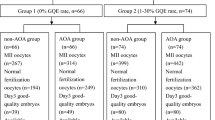Abstract
Purpose: Recent studies showed a beneficial effect of reducing the time of sperm–oocyte interaction on fertilization, division, and implantation rates of the oocytes obtained from randomized patients. In the present study, the effects of reduced insemination time on fertilization and embryo development were evaluated by using sibling oocytes from the same patient.
Methods: A total of 464 oocytes from 36 patients was randomly allocated to be inseminated for either 1 hr (reduced) or 18 hr (regular).
Results: Fertilization rates were not significantly different between reduced (135/229; 59%) and regular (150/235; 64%) groups. Cleavage rates and embryo quality were similar in both groups. A total of 135 embryos (73 from the reduced and 62 from the regular group) was transferred to 36 patients. Thirty-four embryos implanted in 18 patients (25.2% implantation and 50.0% pregnancy rates).
Conclusions: Fertilization, cleavage, and embryo development from 1-hr insemination is comparable, not superior, to those from an 18-hr insemination time, which is commonly used in in vitro fertilization programs. These data suggest that reduced insemination time can be used during in vitro fertilization to avoid unnecessarily longer exposure to spermatozoa.
Similar content being viewed by others
REFERENCES
Harper MJK: Gamete and zygote transport. In The Physiology of Reproduction E Knobil, JD Neill (eds). New York, Raven Press, 1994, pp 123–187
Bedford JM, Kim HH: Cumulus oophorus as a sperm sequestering device in vivo. J Exp Zool 1993;265:321–328
Gianaroli L, Magli MC, Ferraretti AP, Fiorentino A, Tosti E, Panzella S, Dale B: Reducing the time of sperm-oocyte interaction in human in vitro fertilization improves the implantation rate. Hum Reprod 1996;11:166–171
Aitken RJ, Buckingam DW, West K, Brindle J: On the use of paramagnetic beads and ferrofluids to assess and eliminate the leukocytic contribution to oxygen radical generation by human sperm suspension. Am J Reprod Immunol 1996;35:541–551
Krausz C, Mills C, Rogers S, Tan SL, Aitken RJ: Stimulation of oxidant generation by human sperm suspensions using phorbol esters and phormyl peptides: Relationships with motility and fertilization in vitro. Fertil Steril 1994;62:599–605
Nasr-Esfahani MH, Aitken JR, Johnson MH: Hydrogen peroxide levels in mouse oocytes and early cleavage stage embryos developed in vitro or in vivo. Development 1990;109:501–507
Waldenstrom U, Hamberger L, Nilsson L, Ryding M: Short-time sperm-egg exposure to prevent zona hardening. J Assist Reprod Genet 1993;10:OC 245
Gianaroli L, Fiorentino A, Magli MC, Ferraretti AP, Montanaro N: Prolonged sperm-oocyte exposure and high sperm concentration affect human embryo viability and pregnancy rate. Hum Reprod 1996;11:2507–2511
Bergh C, Waldenstrom U, Hamberger L: Reducing the time of spermatozoa-oocyte interaction in human IVF improves the implantation rate (Letter to the Editor). Hum Reprod 1996;11:1809–1813
Walters DE: Reducing the time of spermatozoa-oocyte interaction in human IVF improves the implantation rate (Letter to the Editor). Hum Reprod 1996;11:1809–1813
Yanagimachi R: Mammalian fertilization. In The Physiology of Reproduction E Knobil, JD Neill (eds). New York, Raven Press, 1994, pp 189–317
Baker HWG, Brindle J, Irvine DS, Aitken RJ: Protective effect of antioxidants impairment of sperm motility by activated polymorphonuclear leukocytes. Fertil Steril 1996;65:411–419
Hall J, Fishel S, Green S, Fleming S, Hunter A, Stoddart N, Dowell K, Thornton S: Intracytoplasmic sperm injection versus high insemination concentration in-vitro fertilization in cases of very severe teratozoospermia. Hum Reprod 1994;9:493–496
Oehninger S, Kruger TF, Simon T, Jones D, Mayer S, Lanzendorf S, Toner JP, Muasher: A comparative analysis of embryo implantation potential in patients with severe teratozoospermia undergoing in-vitro fertilization with a high insemination concentration or intracytoplasmic sperm injection. Hum Reprod 1996;11:1086–1089
Yang D, Shahata MA, Al-Bader M, Al-Natsha SD, Al-Flamerzia M, Shawaf TA: Intracytoplasmic sperm injection improving embryo quality: Comparison of the sibling oocytes of nonmale factor couples. J Assist Reprod Genet 1996;13:351–355
Author information
Authors and Affiliations
Rights and permissions
About this article
Cite this article
Coskun, S., Roca, G.L., Elnour, A.M. et al. Effects of Reducing Insemination Time in Human In Vitro Fertilization and Embryo Development by Using Sibling Oocytes. J Assist Reprod Genet 15, 605–608 (1998). https://doi.org/10.1023/A:1020333427698
Issue Date:
DOI: https://doi.org/10.1023/A:1020333427698




